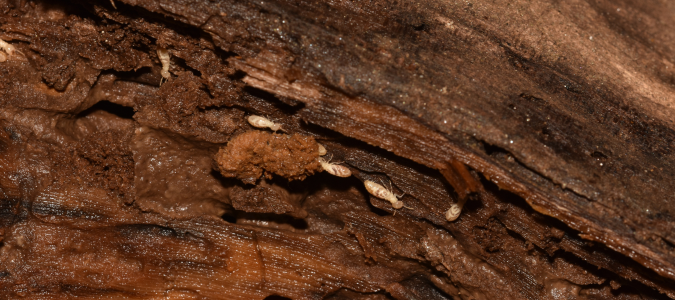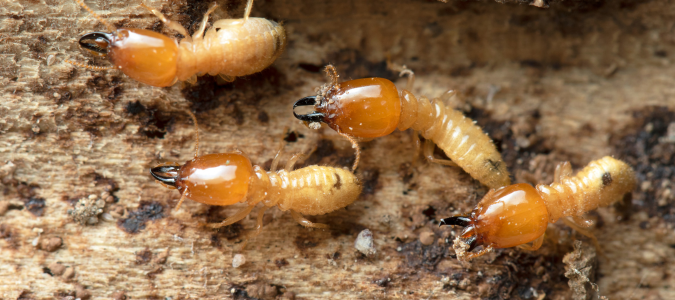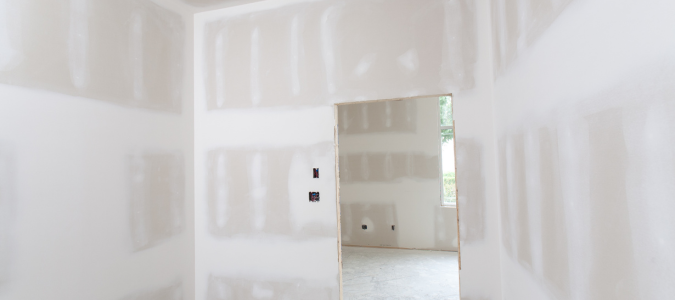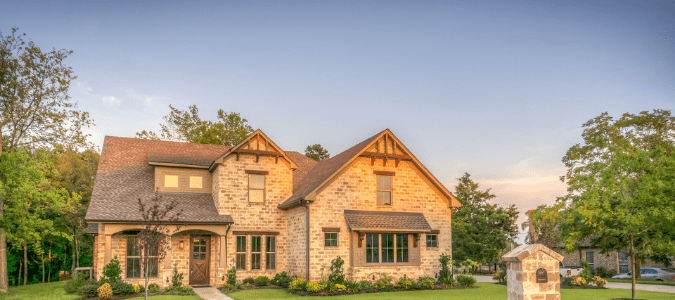Signs of Termite Damage in Wood

Signs of Termite Damage in Wood
Termites are invasive pests that can cause significant and costly structural damage to your home. It’s important for homeowners to stay vigilant about the common signs of termites so they can work with a pest control professional to catch a termite infestation early.
Generally, the sooner you address the infestation, the less structural home damage you’ll have to worry about. Keep in mind that since termites tunnel through wood, it’s more common to notice the signs of an infestation than to see the termites themselves.
What many homeowners don’t know is that there are several ways that termites can cause damage in wood. Let’s break down the common signs of termite damage in wood and how you should address them.
Hollow Wood
The most well-known sign of termite damage is hollow wood. Unfortunately, hollow wood is an indicator of a well-established termite infestation, as it takes time for termites to chew through the wood from the inside out.
Identifying hollow wood is difficult because it’s not a visual sign of termites. Instead, you have to knock on the wood and listen for a hollow sound to know whether or not termites are inside. A piece of wood can be completely hollowed out on the inside and still fully intact on the outside.
You may hear hollow wood in your walls, on your floors, in your beams and around your door frames. If you suspect a termite infestation in your home, walk around your house and knock on the wood in these areas. If you hear a hollow sound in any of them, contact a pest control specialist.
Blistering or Bubbling Paint
Subterranean termites require moisture to live and the tunnels they create have a certain level of moisture to them. Unfortunately, this can cause your paint to blister and bubble.
To spot this sign, inspect your walls, window sills and painted furniture for damage in the paint. Next, knock on the damaged areas and listen for a hollow sound. If you hear it, contact a pest control specialist.
Termite Mud Tubes
Subterranean termites build structures that they use to travel between their food source and their shelter called mud tubes. Mud tubes are typically the width of a pencil and are made of a combination of soil, termite saliva, termite droppings and wood. The color varies based on how fresh they are, termite activity and the type of soil used to build them.
Termites build a system of mud tubes that branch off from each other. They often look like multi-pronged forks. They run both vertically and horizontally.
You may spot mud tubes around your home’s foundation, walls and crawl spaces. They are a sign that a termite infestation is likely nearby, so it’s important to contact a pest control specialist if you see mud tubes around your home. They know how to identify subterranean termite tubes and control an infestation in your home.
Splintered and Damaged Wood
When termites chew through wood, they create a honeycomb-like interior. This can also cause the outer layer of wood to splinter and thin out. If you notice damaged wood around your home, gently touch it with a screwdriver. If it falls apart easily, it could be due to termite damage.
Contact a pest control specialist if you notice damaged wood in or around your home. The more damage termites cause, the more costly the repairs. Catching an infestation early is key to saving you time, money and headaches.

Can a Termite-Infested House Be Saved?
It’s never too late to treat a termite infestation, even if the termites have already done significant damage. There are several effective professional solutions to treat termites, even if you have a large infestation. Do not wait to act because you believe it is a lost cause.
The sooner you take action on a termite infestation, the easier it will be to restore the damage done to your home. A pest control professional can also help you put prevention measures in place to deter termites from reentering your home.

How Do You Tell if Termites Are Behind Drywall?
One of the sneakiest places where you might find termite activity is behind your drywall. Since the wood behind drywall isn’t visible, termites can cause significant damage without being detected. Luckily, there are a few signs of termites behind drywall that you can look out for.
First, you may notice tiny pinholes in your drywall. Termites create these so they can pass through the walls. They may appear alone or in clusters, and they are often sealed with mud.
Next, as termites damage the wood behind your drywall, it may cause the paint to bubble, crack or appear uneven. You may also hear a hollow sound when you knock on your drywall.
Finally, you may notice discarded wings around your drywall or near windowsills. Reproductive termites have gray or brown wings that they shed after their nuptial flight. Once they reach maturity, reproductive termites leave their nests for a “mating flight” to establish new colonies. The mating flights take place in late spring or early summer, so if you see discarded wings around your home during this time, there could be more termites inside your drywall.
Remember, termites eat wood from the inside out, so they can cause significant damage before you notice them. It’s important to look out for these signs to identify a termite infestation.
Control Termites With Help From the Pros
A termite infestation should not be taken lightly and requires professional treatment. Your local pest control specialist has the expertise and tools needed to control these unwanted pests in your home. They will also advise you on prevention measures to protect your home for the future.
If you suspect that termites have damaged the wood in your home, reach out to a pest control specialist.
Chem-Free Can Handle Your Termite Problems
Due to the potential damage termites can bring to your home, the best route to take is to contact a reliable pest control specialist. The pest control professionals at Chem-free will be able to locate the termite colony residing in or near your home. They will create a termite treatment plan for your property.
Need Help Managing Pests?
Chem-Free offers both effective, low-impact pest control options and preventative measures to help avoid future infestations. Contact us today for a free estimate!


